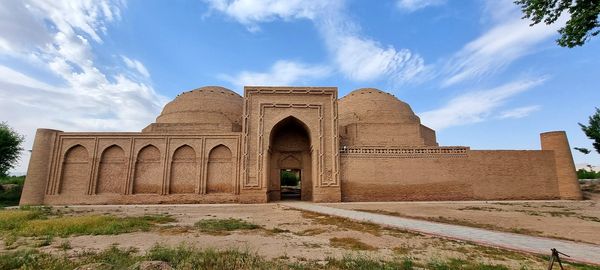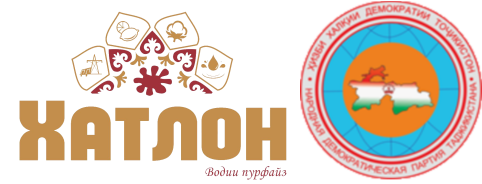
Khoja Mashhad Madrasah
Khoja Mashhad Madrasah
This magnificent madrasah and mausoleum dates back to the 9th-12th centuries and is located 8 km south of the center of Shahrituz district.
Khoja Mashhad Madrasah consists of two large halls, which are covered with a dome. The height of the right dome is 13 meters and the left wing is 24 meters. The hall on the right is the place where students study and they pray in the hall on the left, because there is an altar on the qibla side of this hall.
At present, 23 graves are buried inside the left hall and 22 graves are buried inside the right one, according to Azimov Davlatmurod, an observer, who is a descendant of Hazrat Khoja Mashhad. Here Khmelinsky, an archaeologist, excavated in the 1950s and studied the graves. Rooms for students have been built about 100 m north of the madrassa. In the eastern part of the madrasah, and according to the librarian, there was a library there.
In connection with the Khoja Mashhad madrasah, domestic and foreign researchers and historians have carried out certain research and work.
They have made a valuable contribution to the identification of obscure aspects of the history of its origin, the construction of this cultural monument and its presentation to the world.
It is worth mentioning the valuable services of the famous historian and archeologist Sergei Grigorevich Khmelnitsky, who for more than 40 years led special excavation and archeological teams, in which he carried out a lot of scientific researches. It was under the direct leadership of this experienced scientist and researcher in the early 60s of the last century that the excavations and archeological works gained a new impetus and clarified many issues. First of all, it was proved that the mentioned monument buildings were not connected at the same time, but in different centuries.
At the same time, it was found that there were 54 graves inside both monuments, appeared not in the IX-XII centuries, but later, during the conquest of Central Asia by the Genghis Khans.
During archeological excavations in the basement and around the building there were found various pottery, candlesticks and other ancient artifacts, some of which are now in the front of the building between the two buildings. G. Khmelnitsky has written many scientific and research articles on the Khoja Mashhad madrasah and the history of its foundation, and presented it to our compatriots and the world.
«Khoja Mashhad Madrasah is of historical significance as the largest madrasah in Central Asia and testifies to the fact that the ancient Qubodiyon was the center of science and culture,» said Alexander Markovich Belenitsky, a well-known orientalist, historian and archeologist, in an article entitled «Mausoleums in the village of Sayat.»
Khoja Mashhad Madrasah was built in the 9th-10th centuries and has a foundation and all the walls of the dome are made of baked bricks. The thickness of the foundation is 3 meters and this structure has withstood all disasters for centuries and has survived to the present day. It was renovated in 2010 with the support of the government.
Добавить комментарий Отменить ответ
Для отправки комментария вам необходимо авторизоваться.
Ҷустуҷӯ
Хабарҳои охирин
- Program of the International Tourism Forum and Exhibition «Welcome to Ancient Khatlon» 20.02.2024
- ФОРУМ ВА НАМОИШГОҲИ БАЙНАЛМИЛАЛИИ САЙЁҲИИ МАРҲАБО БА ХАТЛОНИ БОСТОН TOURISM FORUM AND EXHIBITION WELCOME TO ANCIENT KHATLON 20.02.2024
- Натиҷагирии фаъолияти Кумитаи рушди сайёҳӣ дар соли 2023 ва вазифаҳо барои соли 2024 09.01.2024
- Achievements of the tourism sector of the Khatlon region 18.12.2023
- Мақбараи Мавлоно Қутбиддини Нишопурӣ/Мавзолей Мавлоно Кутбиддина Нишопури/Mausoleum of Mavlono Qutbuddin Nishopuri 04.12.2023
Хазина
- Февраль 2024 (2)
- Январь 2024 (1)
- Декабрь 2023 (2)
- Ноябрь 2023 (5)
- Октябрь 2023 (9)
- Сентябрь 2023 (7)
- Август 2023 (2)
- Июль 2023 (13)
- Май 2023 (5)
- Апрель 2023 (1)
- Март 2023 (30)
- Февраль 2023 (21)
- Январь 2023 (16)
- Декабрь 2022 (8)
- Ноябрь 2022 (7)
- Август 2022 (9)
- Июль 2022 (4)
- Апрель 2021 (11)
- Март 2021 (8)
- Июль 2020 (4)
- Июнь 2020 (6)
- Апрель 2020 (2)
- Март 2020 (2)
- Февраль 2020 (2)
- Январь 2020 (2)
- Октябрь 2019 (3)
- Июль 2019 (3)
- Июнь 2019 (6)
- Май 2019 (3)
